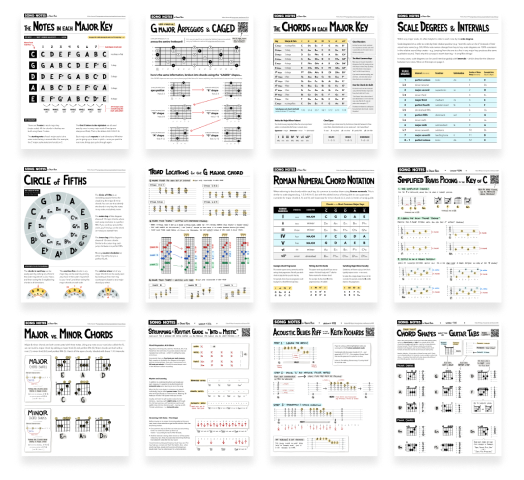Simple Twist of Fate
by Bob Dylan • Lesson #351 • Feb 12, 2021
Video lesson
Editor’s notes
Hey friends! Here’s a new guitar lesson teaching you how to play “Simple Twist of Fate”, the classic from Bob Dylan’s 1975 album Blood on the Tracks. This is no doubt one of my favorite songs of all time, from an equally amazing album. This lesson teaches aims to make this song more accessible, teaching it in standard tuning, no capo, using chords in the key of E (which is slightly different than Dylan’s open-D-tuning, capo 2, Key of D arrangement). I’ll explain all this in my video and PDF – showing you the chords / progression / strumming, before offering two playthroughs using different strum patterns. I hope you enjoy!
Video timestamps:
- 0:00 Preview & lesson summary
- 1:49 Notes on tuning, capo, and key
- 2:50 Chord shapes & basic progression
- 9:31 Basic strumming
- 11:50 Playthrough (basic strum, with tab)
- 13:42 Advanced strumming
- 17:10 Playthrough (adv strum, with lyrics)
Licensed Song Sheet 3 pages
Follow along with my print-friendly guide for this song! It’s available for purchase at Musicnotes.com, the web’s leading provider of licensed sheet music.
On the fence? Here's a guide I made showing the purchase & print process, including answers to common questions about my song sheets.
Buy at Musicnotes.comA note about tuning, capo, and how Dylan plays this song
My video lesson & this PDF teaches this song in standard tuning, using no capo – as the goal of this arrangement is to keep things accessible & approachable. But I should note, Dylan doesn’t play the song the way I am showing! He’s using capo 2nd fret, in open D tuning (D-A-D-F#-A-D). Maybe I’ll make a lesson for playing this song that way someday, but note – that’s not what I’m doing in this lesson.
Chord shapes
At a glance, the chords I use are as follows (shown in tab form). For the E-Emaj7-E7 sequence, I prefer using the four-string voicing shown here as my foundation. This allows you to capture the sound of the descending bass note within those three chords, which is vital to capturing Dylan’s sound.
For the B chord, I’ll use this Bsus4 voicing I show below — which is far easier to play than a typical B-major chord (since you don’t have to barre anything). This version of the B also captures the vibe of Dylan’s version (via the thinnest two strings being open), which gives off an open-tuning sound.
For the A-major chord, I often will freely switch to an Asus2 to mix up the sound, which again captures the open-tuning vibe of Dylan’s version.
[ See my sheet music for tabs]
Sometimes I’ll flirt with playing 6-string versions of the E-Emaj7-E7 sequence, using the voicings shown below. If you do this, try to lead into each chord by playing the bass notes (4th string) as I show here — which attempts to capture the very important descending tone. What I don’t love about this, is how muddy the Emaj7 sounds — so if anything, that’s the chord (of the 3 shown below) where I usually revert to the 4-string version.
[ See my sheet music for tabs]
Strumming patterns
The most basic strum you’ll want to do is a “bass, DOWN, bass, DOWN” where “bass” refers to the thickest string used in whatever chord you’re playing. I slightly emphasize the down-strums.
[ See my sheet music for diagram ]
To strum like Dylan, use one of the two patterns below. Keep all up-strums light, staying on the thinnest 2-3 strings only. Keeping an accent on beats 2 & 4 also sounds good, if you can manage.
[ See my sheet music for diagram ]
Chord progression
Here’s the chord progression this entire song uses, over and over. There are four beats per measure. Set your metronome to 137 BPM to play this along with Dylan’s version.
E Emaj7 E7 A
1 2 3 4 1 2 3 4 1 2 3 4 1 2 3 4 1 2 3 4 1 2 3 4 1 2 3 4 1 2 3 4
Am E B A E B E
1 2 3 4 1 2 3 4 1 2 3 4 1 2 3 4 1 2 3 4 1 2 3 4 1 2 3 4 1 2 3 4
Enjoy my lessons? Buy me a beer!
If this and my other lessons have proven helpful to you, please consider making a one-time donation to my tip jar. Contributions of any amount help make this project possible (including the many, many hours I put into it).
Fun & Helpful Tools I've Made
Subscribe to my YouTube channel
Be sure to never miss a lesson by subscribing on YouTube. I put out 2-3 new videos every week. These include full song lessons, as well as covers, practice tips, behind-the-scenes updates. Thanks!
Recent Lessons
-
May 10, 2024
"Wichita Lineman" by Glen Campbell
-
May 1, 2024
Tour of My New "KeyMaster" Web Tool
-
April 24, 2024
13 Must-Know Riffs with Droning Strings
-
April 18, 2024
"Moonshadow" by Cat Stevens
-
April 12, 2024
Playing Songs "Correctly" vs. When to Cut Corners
-
April 9, 2024
Chords & Music Theory... 9 New Lessons!
-
March 30, 2024
Gordon Lightfoot's "Carefree Highway"
-
March 22, 2024
Lead Guitar & the F1 Theme Song
-
March 15, 2023
Pink Floyd's "Breathe" - with Simpler Chords Included
-
March 6, 2024
Q&A: 8 Tips to Avoid Muting Strings
-
March 1, 2024
Blues Shuffle Riffs - Using Just 2 Strings!


